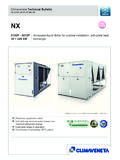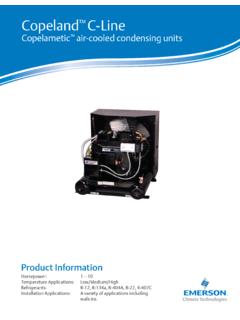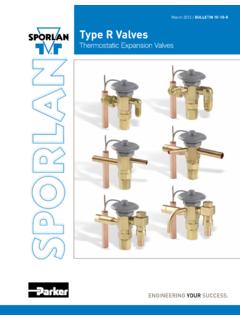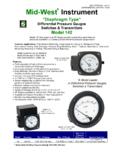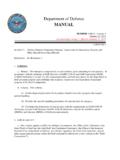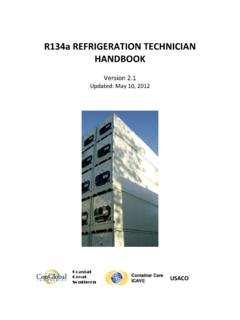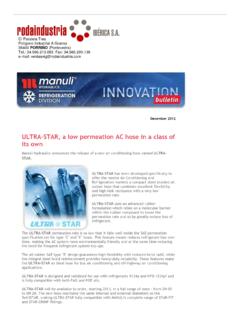Transcription of Operator Installation & Instructions HERMETIC LIQUID ...
1 Operator Installation & InstructionsHERMETIC LIQUIDREFRIGERANT PUMPSCAM AND CNF SERIESB ulletin HP237bFEB 2011 Ideal for LIQUID Overfeed, LIQUID Re-Circulation, LIQUID Transfer and LIQUID Pressure BoostCAM 2/3 Pump (shown bare) HERMETIC pumps are superior pumps for refrigeration systems because they are sealless, requiring no oil or grease lubricant, are very smooth and quiet, are not bothered by frost or moisture, and normally provide many years of reliable operation. Like many fine pieces of machinery, HERMETIC pumps must be properly installed with regard to system layout, sizing, and controls so that the pump receives adequate LIQUID which is free of gas bubbles and abrasive particles.
2 Following these Instructions helps guarantee a long and trouble-free pump life. MATERIAL SPECIFICATIONS Casing: Ductile Iron A356 ( ) Stator casing: Steel A529 Grade 40 Stator lining (Can): Stainless Steel A276 type 346T Shaft: Chrome Steel A22C type 420 Impeller: Cast Iron A48; CAM Class 30, CNF Class 35 Sleeves: Stainless Steel A276 type 346T Bearings: CarbonMaximum operating pressure: 362 PSIG (25 bar) or 600 PSIG (40 bar)Temperature range: -60F to 194F (-51 C to 90 C) Lower Temperature: to -150F with stainless steel construction (contact Hansen)Housing: NEMA 4 construction (IP64/IP67/IP55) CSA Listed: File No.
3 LR75907-2CO2 pump available; contact Hansen. PUMP EQUIPMENT Figure 1 depicts a typical pump and accessories as would be supplied by Hansen. Pumps come complete and pretested. Please note the protection devices which are provided with the pump. One should become familiar with each or these devices and understand how, when properly installed and utilized, they can help to ensure a long and trouble-free pump life. FIGURE 1Q-MAX ORIFICE1/4" FPT X 1/4" BSPQ-MIN ORIFICEDIFFERENTIALASSEMBLYPRESSURESTATS TART-UPDISCHARGE PORT ADAPTEROPTIONAL CONSTANTFLOW REGULATORELECTRICAL CONDUIT HUBPUMP PROTECTION DEVICESMOTOR COOLINGCAVITATIONIN S TA LLA TIO NFLOW LIMITING(FOR DIFFERENTIALPRESSURESTAT)(BY-PASS)(OR DRY RUNNING)HANSEN TECHNOLOGIESCORPORATIONPUMP STATUS(Low p)RunningCavitatingO ff 3 M inutes: CautionOff.
4 Excess CavitationsOff Due to Low LevelOff Due to Motor Overtemperature(Auto Restart)(Alarm ) (M anual R eset B utton)(Auto Restart)(Motor Option) (Auto Restart)M anual R eset B uttonPUMP GUARDIAN(ALTERNATE TOSTANDARDSTATUSNEGATIVE PUMPQ -M A X O R IFIC E)2HP237bFEB 2011 PUMP SUCTION LINE Proper pump suction line sizing helps to minimize bubbling and vortexing of the LIQUID refrigerant which can cause cavitation or loss of prime. For ammonia, t ypical pump suction line sizing should deliver an optimum 3 feet per second flow rate from the accumulator vessel (pump recirculator).
5 For halocarbons, a flow rate of feet per second is optimum. The suction line should be sized for the maximum allowable pump flow, not the nominal design flow, because pump demand can vary widely due to system demands such as defrost termination and production start up. Undersizing the suction line is not tolerable, while oversizing should not exceed 1 or 2 pipe sizes. Suction line pipe sizing is listed in Table 1. The pump inlet flange connection is normally one or two sizes smaller than the pump suction line pipe.
6 Reducers on the pump inlet should be eccentric with flat side on top to avoid bubble accumulation in the suction line. SUCTION LINE PIPE SIZING (IDEAL) PIPE SIZER717 GPMCO2 &HALOCARBON GPM1" "12 . " . 82" " " " " " " thru 1 "= Schedule 80; 2" thru 6"= Schedule 40 Basis: R717 at 3 ft/sec; CO2 and Halocarbon at ft/sec TABLE 1 Adequate NPSH (Net Positive Suction Head) is necessar y to minimize the potential of cavitation during normal operating conditions. Typically, NPSH is defined as the static head of LIQUID (in feet) above the centerline of the pump inlet; see Figure 3.
7 Insufficient available NPSH can cause the loss of pump pressure and lubrication; eventually leading to shortened pump bearing life. The system required minimum NPSH values for each pump are specified in the Standard Pump Specifications on page 20. Avoid any unnecessary pressure drop in the pump suction line from valves, strainers, and fittings. When required, they should be sized for minimum pressure drop. The pump suction line should be as short as possible and ideally piped with a steady downward slope to the pump.
8 Horizontal runs should not exceed 18 inches. Baffle plates should be installed in the accumulator above the exit to the pump to eliminate vortex formation. The LIQUID level inside the vessel should be a minimum of ten inches above the vessel internal inlet to the pump suction line and located away from evaporator overfeed return, LIQUID makeup, hot gas condensate return and other piping arrangements. Some examples of correct and incorrect routing of suction piping are shown in Figure 2.
9 The pump suction line, vessel, level column, and float switches should be insulated to minimize boiling of refrigerant . FIGURE 23HP237bFEB 2011 PUMP DISCHARGE LINE The discharge line of a Hansen HERMETIC pump normally must include a Q-max flow (capacity) control orifice (see page 3) or Constant flow (capacity) regulator (see page 4) to limit maximum flow to prevent cavitation and possible motor overload. Centrifugal pumps of all makes, whether canned or seal design, can operate inefficiently or at a higher NPSH than the required region on the pump performance curve if capacity is not controlled.
10 Typical pump discharge line sizing for ammonia should be based on a maximum of 7 feet per second and 5 feet per second for halocarbons; see Table 2. MAXIMUM RECOMMENDED FLOW IN PUMP DISCHARGE LINEPIPE SIZER717 GPMC02 & HALOCARBON GPM1"17121 "27191 "3 8272"63492 "107763"1661104"274196 Basis: R717 at 7 ft/sec; CO2 and Halocarbon at 5 ft/sec. TABLE 2 Normally, a check valve is located after the flow control device to prevent back flow and reverse rotation of the pump when multiple pumps are in parallel.

